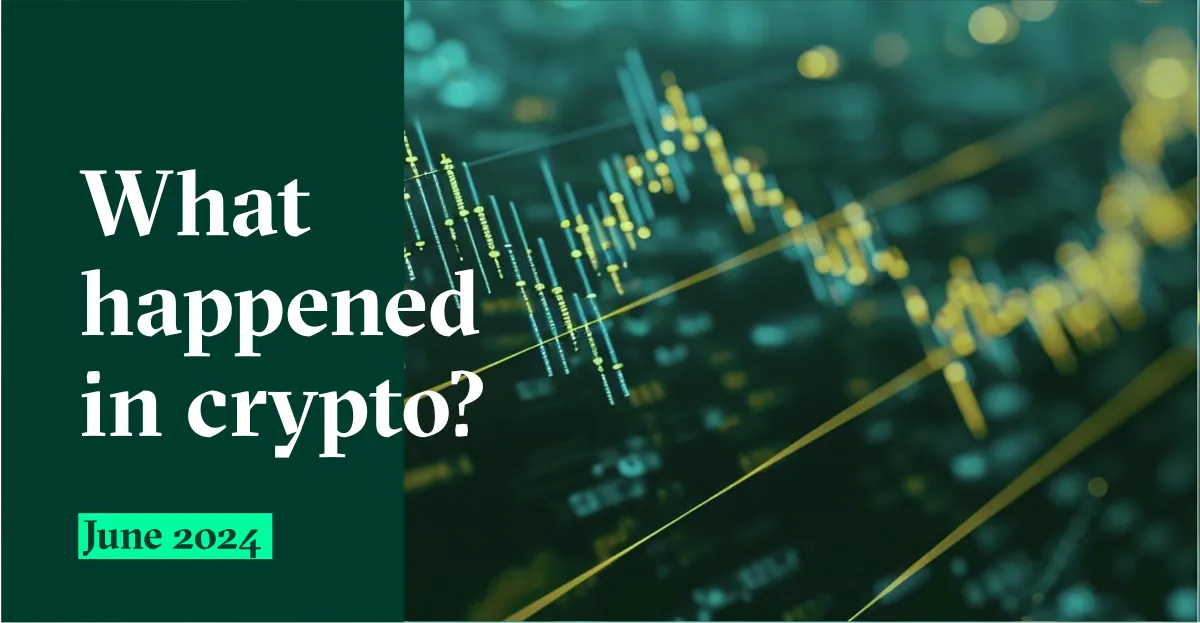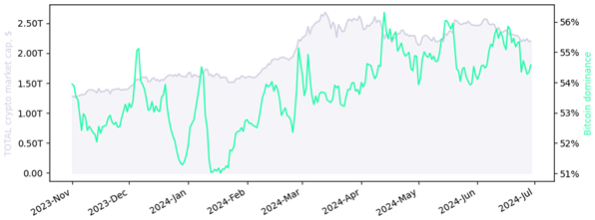Bitstamp Monthly Briefing – June 2024

Welcome to the June edition of the Bitstamp Monthly Briefing. In this blog post, we'll cover the latest crypto market trends, the newly implemented MiCA regulation in the EU, and key events that are shaping the cryptocurrency landscape. We'll also highlight which assets gained and which ones lost value this month, along with sharing insightful reads to keep you ahead of the curve.
Read on to stay informed and up to date.
Market update
The total crypto market cap decreased by 8.1% month-over-month, hitting $2.26 trillion at the end of June. Trading volume on the leading crypto spot exchanges we monitor saw a 17% decrease during this period.
BTC's market dominance increased by 0.6 percentage points month-over-month to 54.8%.
Total crypto market cap (grey) and BTC dominance (green)

Past performance is not a reliable indicator of future results. The performance of crypto assets can be highly volatile. Data taken on July 1, 2024.
Source: Total crypto market cap, Bitcoin dominance
Top performing CMC 100 assets in June
- +75.2% Brett (Based) (BRETT) – The meme coin saga continues.
- +38.3% Kaspa (KAS) – Several factors such as a positive market sentiment and institutional involvement helped to push the price higher.
- +30.9% Mog Coin (MOG) - MOG exemplifies a well-executed meme coin strategy.
Worst performing CMC 100 assets in June
- -46.5% Chiliz (CHZ) – The price failed to hold the $0.12 support level and declined further.
- -42.6% Beam (BEAM) - The price failed to breach the $0.03 resistance at the beginning of June.
- -41.5% Starknet (STRK) - The consistent transfer of large volumes of STRK tokens to OTC platforms contributes to the bearish trend.
Past performance is not a reliable indicator of future results. The performance of crypto assets can be highly volatile. Data taken on July 1, 2024.
Key macro & crypto events in July 2024
- July 3: FOMC Minutes
- July 4-31: Japan Blockchain Week 2024
- July 8: BTC Summit in Brussels, Belgium
- July 9: FED Chair Powell Testimony
- July 11: US Core Inflation Rate
- July 11-14: Mallorca Blockchain Days 2024
- July 17: Web3 Future 2024 in Tokyo, Japan
- July 18: Governing Council of the ECB: monetary policy meeting in Frankfurt
- July 19-21: BIOTC (Blockchain and Internet of Things Conference) in Fukuoka, Japan
- July 25-27: Bitcoin2024 in Nashville, TN
A landmark crypto licensing regime MiCA
On June 30, 2024, the European Union reached a significant milestone in the global regulation of cryptocurrencies with Markets in Crypto-Assets (MiCA) titles III and IV (asset-referenced tokens and e-money tokens) coming into force.
MiCA is comprised of seven sections - called titles - in total. As a whole, the legislation aims to provide a comprehensive regulatory framework for crypto assets, covering aspects such as transparency, disclosure, authorization, and supervision. MiCA defines crypto assets that use decentralized ledger technology (DLT), with specific distinctions between various types of crypto assets. The regulatory framework covers three distinct crypto assets: asset-referenced tokens (ARTs), e-money tokens (EMTs), and other crypto assets such as utility tokens (crypto assets that are not EMTs or ARTs). The legislation extends further by imposing stricter regulations on certain stablecoins, mandating legally binding stabilization mechanisms to ensure they are properly backed with sufficient liquidity, thereby bolstering user confidence.
The regulation is designed to ensure market integrity, financial stability, and enhanced consumer protection across the EU's 27 member states.
The degree of preparedness among crypto companies varies widely. Larger, well-established firms with ample resources may have already started adapting their operations to meet MiCA requirements. These companies invested in compliance infrastructure and obtained legal counsel to ensure the new standards were met by the deadline.
However, smaller companies and startups may find the transition more challenging. Many are still in the process of understanding MiCA's full implications and assessing the necessary steps to comply. The phased implementation of MiCA, with different provisions coming into effect at different times, adds another layer of complexity to the compliance process.
In an interview with Coindesk, Bitstamp exchange said, “For those new to this business and coming into the European market, it is a step change in how they operate. If you’re new to this space, you’re not going to have very stringent AML requirements for account opening. If you’ve already been regulated in the EU, you’re probably in pretty good shape.”
There is a general market consensus that regulation is necessary to protect consumers and ensure market stability, and the sentiment within the industry is cautiously optimistic. Many view MiCA as a double-edged sword: it offers much-needed clarity and protection on one hand but also imposes significant operational burdens on the other, with increased compliance costs and the complex regulatory landscape MiCA introduces.
The key to successful implementation will be balancing these aspects to foster a competitive and innovative crypto market in the EU, as the regulation is also expected to attract more institutional investment due to the legal certainty it provides.
Recommended reads
The Evolution of Memes and Their Place on Blockchains by Galaxy Research
Despite skepticism regarding their utility, meme coins leverage centuries of viral storytelling and are crucial in driving blockchain adoption. Their significance lies not in their inherent value but in how they use blockchains as a new medium for communication and cultural exchange. As blockchains gain traction, meme coins symbolize the evolution of digital expression, akin to historical advancements like newspapers, cars, television, and the internet, all of which had a profound impact on society and became widely adopted technologies.
How do we Value Tokenized Projects? By Blockchain Coinvestors
This newsletter argues that the traditional discounted cash flow (DCF) valuation remains the best method for valuing assets, despite its imperfections, such as heavy reliance on terminal values. Applying DCF to new industries like blockchain can be challenging due to unknown variables. Historical examples, like the 1990s internet companies, showed the eventual shift from speculative to fundamental valuations. Currently, with the advent of digital assets and upcoming US Ethereum Spot ETFs, investment analysts are grappling with categorizing and valuing these assets. The authors look to Van Eck's recent application of DCF to Ethereum which demonstrates that traditional valuation methods can be adapted, highlighting Ethereum's potential for high valuation due to its decentralized, open-source nature. The "Fat Protocol Thesis" suggests that the value of blockchain protocols like Ethereum could surpass that of the applications built on them, potentially making Ethereum more valuable than companies like Microsoft in the long term.
Overview of Real World Assets on Solana by Reflexivity Research
Real World Assets (RWAs) represent a significant innovation in blockchain technology, bringing off-chain financial assets like real estate and commodities onto the blockchain through tokenization. This development merges traditional finance with decentralized finance (DeFi), creating a global, programmable financial infrastructure. While Ethereum is the current leader, Solana is emerging as a strong contender for RWAs due to its high throughput, robust DeFi ecosystem, and strong developer community. Despite the dominance of centralized stablecoins, there has been a notable rise in the tokenization of other RWAs, driven by higher interest rates and growing infrastructure, with Solana well-positioned to capitalize on this trend. Tokenization enhances liquidity, accessibility, and trading efficiency, offering new opportunities and democratizing access to traditionally restricted markets. Solana’s advantages, such as low gas fees, high transaction speeds, and advanced token standards, make it an attractive platform for RWA deployment and integration.
Situational Awareness: The Decade Ahead by Leopold Aschenbrenner
In a series of essays on the next ten years of AI, the author debates that San Francisco is at the forefront of a seismic shift in AI development, with American industries gearing up for massive investments in computing power, forecasting the rise of trillion-dollar clusters. The race for Artificial General Intelligence (AGI) has begun, with machines predicted to surpass human intelligence by the end of the decade, potentially sparking unprecedented national security measures. While mainstream analysts remain skeptical, a select group in San Francisco and AI labs possess a unique situational awareness, having accurately predicted recent AI advancements. Whether their visions shape the future or remain a historical footnote, the upcoming decade promises significant and possibly thundering technological evolution.
No information in this blog is intended to provide any personal investment services or advice nor is it an investment recommendation. Clients are responsible for making their own investment decisions. Bitstamp accepts no responsibility for any damage and/or loss arising from the use of information provided herein. Past performance is not necessarily an indicator of future results. Please consider your individual position and financial goals before making an independent investment decision.
Bitstamp is licensed to engage in virtual currency business activity by the New York State Department of Financial Services. Licensed as a Money Transmitter by the New York State Department of Financial Services.
Not offered in the following states: Hawaii and Nevada.
Bitstamp UK Limited is registered with the UK's Financial Conduct Authority. Please read the Risk Warning Statement before investing. Cryptoassets and cryptoasset services are not regulated by the Financial Conduct Authority. You are unlikely to be protected if something goes wrong. Your investment may go down as well as up. You may be liable to pay Capital Gains Tax on any profits you earn.